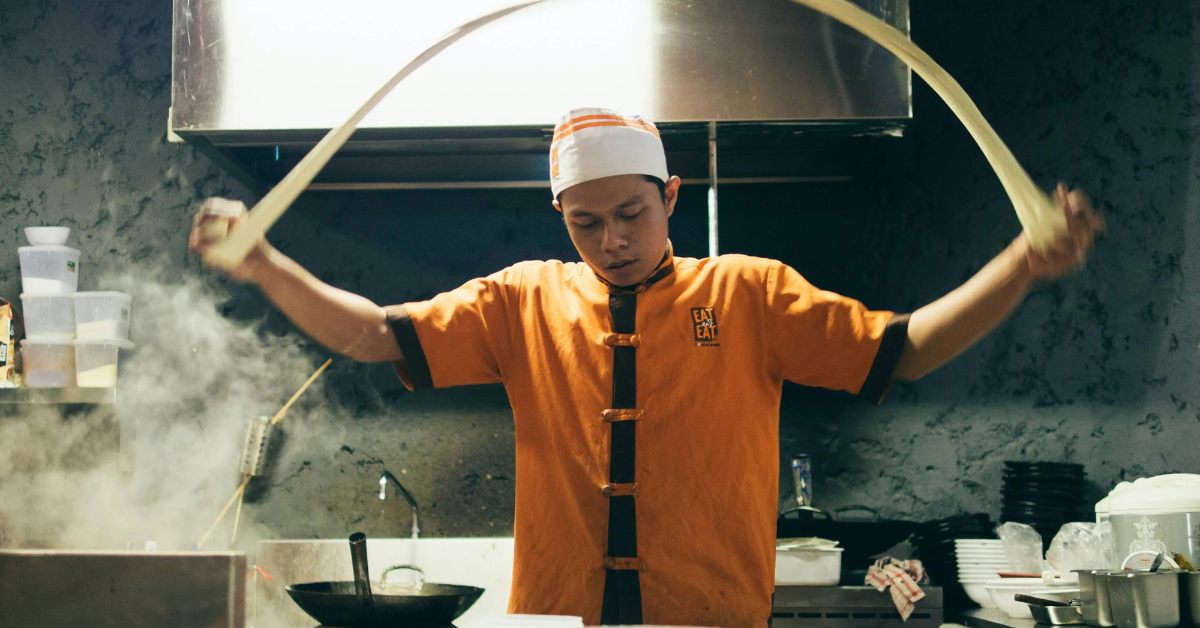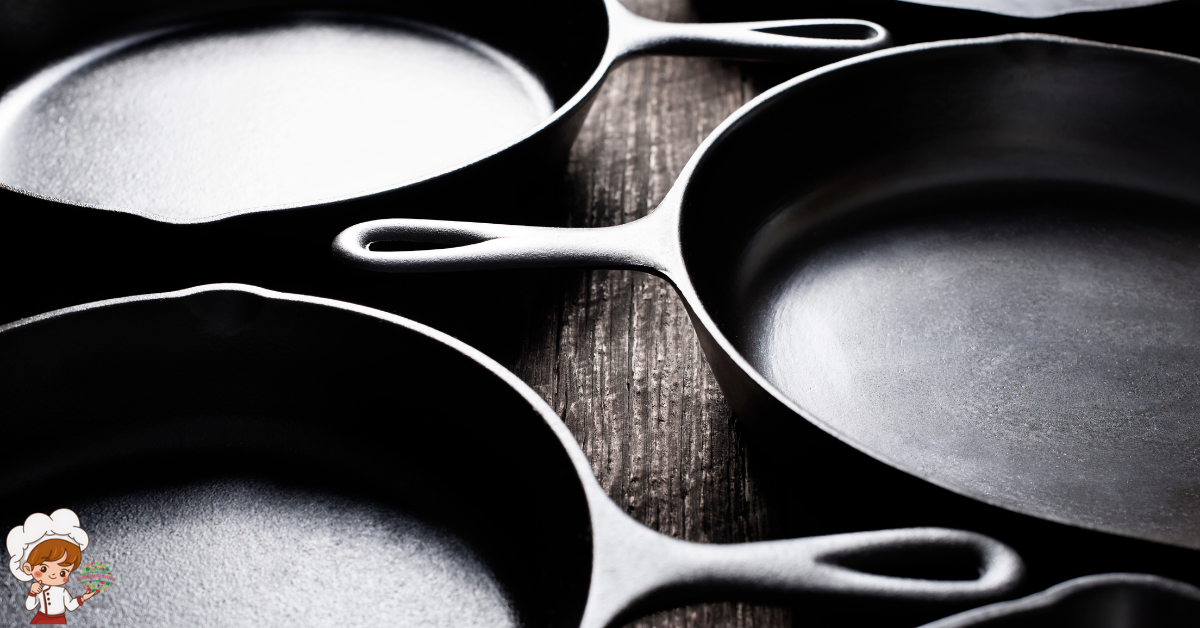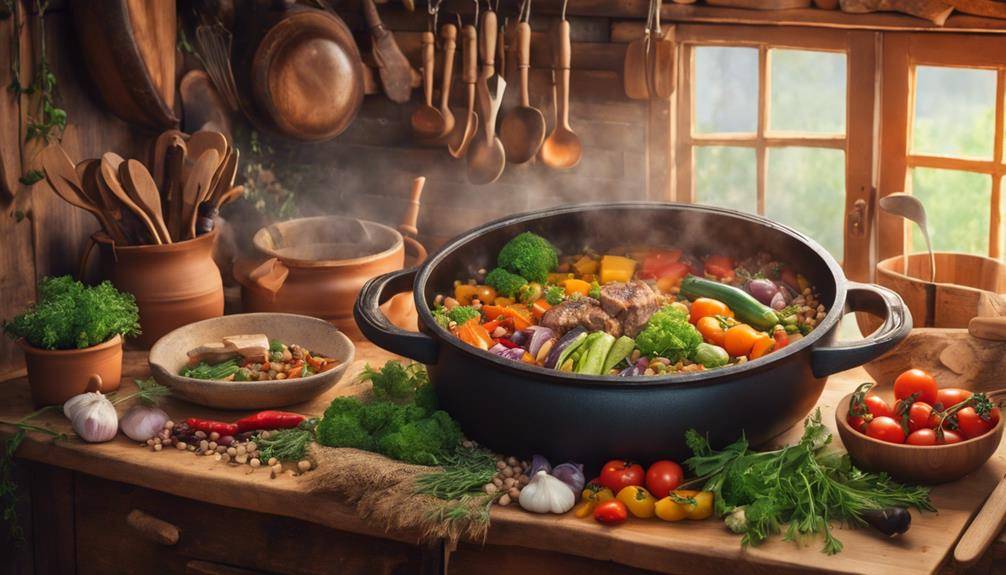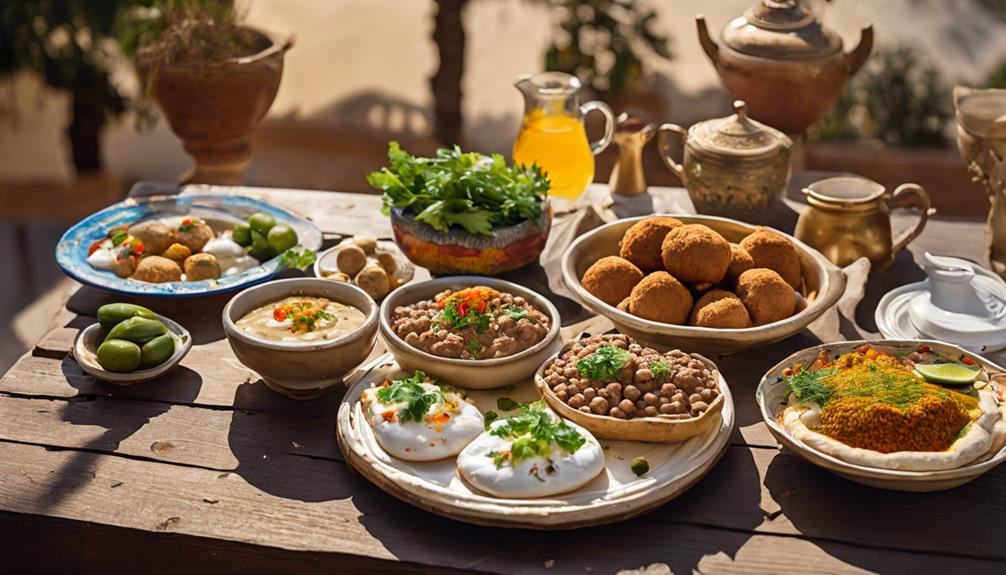The Exciting Art Of Chinese Noodle-Making

Have you ever wondered how those deliciously chewy and flavorful Chinese noodles are made? The art of Chinese noodle-making is a craft that has been perfected over centuries. From the humble hand-pulled noodles to the delicate knife-cut noodles, each variety showcases the skill and dedication of the noodle artisans. Take, for instance, the traditional hand-pulled noodles. The process involves skillfully stretching and twisting the dough until it transforms into long, thin strands. The result? Noodles with a unique texture that perfectly absorbs the flavors of the dish. Whether you’re a noodle lover or simply curious about the art of Chinese cuisine, this exploration into the world of Chinese noodle-making will leave you craving for more.
Origins of Chinese Noodles
Chinese noodles originated in ancient China. The regional noodle history is rich and diverse, with each region having its own unique style and techniques of noodle-making. These noodles hold great cultural significance in Chinese cuisine and are often considered a staple food.
In the northern regions of China, wheat-based noodles, such as hand-pulled noodles and knife-cut noodles, are popular. These noodles are made by hand, with skilled noodle makers stretching and pulling the dough until it forms long, thin strands. The process requires precision and strength, and the end result is a chewy, satisfying noodle that pairs well with hearty sauces and stews.
In the southern regions, rice-based noodles take center stage. These delicate and translucent noodles are made from rice flour and are commonly used in dishes like stir-fries and soups. The texture of these noodles is light and tender, providing a perfect contrast to the bold flavors of the accompanying ingredients.
In the western regions, noodle-making techniques are heavily influenced by neighboring countries like India and Central Asia. Here, you will find hand-pulled and hand-cut noodles, as well as unique varieties like biangbiang noodles, which are wide and thick, and dandan noodles, which are spicy and flavorful.
Chinese noodles have become a symbol of Chinese cuisine worldwide. Their cultural significance extends beyond mere sustenance, as they are often associated with celebrations and special occasions. From street vendors to high-end restaurants, the art of Chinese noodle-making continues to thrive, preserving ancient traditions and delighting taste buds with its wide variety of flavors and textures.
Different Types of Chinese Noodles
In the realm of Chinese noodles, there is a wide array of options to explore and savor. Each region in China has its own unique noodle specialties, with variations in shape, thickness, and cooking techniques. Let’s dive into the world of Chinese noodles and discover the diverse flavors and textures they offer.
In the northern regions of China, you will find the popular “la mian” noodles, which are hand-pulled noodles. These noodles are made by skillfully stretching and twisting the dough until long strands are formed. The result is a chewy and springy texture that pairs perfectly with rich, hearty broths.
Moving towards the east, you will come across the delicate and thin “mian xian” noodles. These noodles are made using a technique called “rubbing noodles,” where a small piece of dough is rubbed between the palms to create thin strands. Mian xian noodles are typically served in a clear, flavorful broth with toppings such as minced pork, mushrooms, and green onions.
In the southern regions, rice noodles take center stage. These translucent noodles, known as “fen si” or “mi fun,” are made from rice flour and water. They have a smooth and silky texture, and are commonly used in dishes like stir-fries, soups, and even desserts.
Lastly, in the western regions, you will find “dao xiao mian” noodles, also known as knife-cut noodles. These noodles are made by pressing a knife against a slab of dough, resulting in irregularly shaped noodles with a rustic charm. Dao xiao mian noodles are often stir-fried with vegetables and meat, creating a satisfying and hearty meal.
With such a wide range of regional noodle specialties and noodle making techniques, Chinese cuisine offers a never-ending exploration of flavors and textures. Whether you prefer hand-pulled noodles, rice noodles, or knife-cut noodles, there is always a Chinese noodle dish to satisfy your cravings. So, go ahead and embark on a culinary journey through the world of Chinese noodles.
Traditional Noodle-Making Techniques
Get ready to discover the fascinating world of traditional noodle-making techniques. Whether it’s the skillful art of hand-pulled noodles or the efficiency of machine-made ones, each method brings its own unique characteristics to the table. You’ll also learn about the regional variations of Chinese noodles, where different areas have their own signature styles and flavors. And finally, we’ll explore the importance of noodle texture, as it plays a crucial role in enhancing the overall dining experience. Let’s dive in and unravel the secrets behind these traditional techniques!
Hand-Pulled Versus Machine-Made
Choose between hand-pulled and machine-made noodles to experience the distinct textures and flavors of traditional Chinese noodle-making techniques. Here’s what you need to know about these two methods:
- Hand-pulled noodle techniques: This ancient method involves using a simple combination of flour, water, and salt. Skilled noodle masters knead the dough to develop its elasticity, then pull and stretch it repeatedly to create long, thin strands. The result is a noodle with a chewy texture and uneven thickness, perfect for absorbing sauces and flavors.
- Machine-made noodle production methods: With the help of modern technology, machines mass-produce noodles using a different process. The dough is mixed, flattened, and cut into desired shapes by automated equipment. This method ensures consistent thickness and uniformity in the noodles, resulting in a smoother texture and a more refined appearance.
Whether you prefer the rustic charm of hand-pulled noodles or the precision of machine-made ones, both techniques offer a unique taste and experience that celebrate the artistry of Chinese noodle-making.
Regional Noodle Variations
Explore the rich diversity of regional noodle variations in China’s traditional noodle-making techniques. Each region in China has its own unique way of making noodles, resulting in a wide array of flavors, textures, and shapes. From the thin and delicate Cantonese rice noodles to the thick and chewy wheat noodles of Shanxi, there is something to suit every palate.
In the north, hand-pulled noodles are a popular choice. These noodles are made by stretching and folding the dough repeatedly, resulting in a springy texture that is perfect for soaking up flavorful sauces. In the south, you will find rice noodles made from ground rice flour, which are often served in soups or stir-fried with a medley of vegetables and meats. Whether you prefer the soft and slippery texture of rice noodles or the hearty bite of wheat noodles, China’s regional noodle variations are a testament to the country’s rich culinary heritage.
Importance of Noodle Texture
To achieve the desired texture in Chinese noodles, it is crucial to carefully follow traditional noodle-making techniques. The texture of the noodles plays a significant role in the overall dining experience, as it affects not only the taste but also the mouthfeel of the dish. Here are four reasons why noodle texture is important and how it can be achieved:
- Noodle Elasticity: The perfect Chinese noodle should have a chewy and springy texture, which is achieved through proper kneading and resting of the dough.
- Cooking Methods: Different cooking methods, such as boiling, stir-frying, or steaming, can further enhance the desired texture of the noodles.
- Thickness Variation: By varying the thickness of the noodles, it is possible to create different textures, from delicate and silky to robust and hearty.
- Sauce Adherence: The texture of the noodles also affects how well they hold onto the sauce, ensuring that each bite is flavorful and satisfying.
Mastering the art of noodle-making techniques is essential to achieving the perfect texture and elevating the dining experience.
The Art of Hand-Pulled Noodles
To master the art of hand-pulled noodles, you need to start with the right dough consistency. Hand-pulled noodles, also known as la mian, are a traditional Chinese noodle dish that requires a unique set of skills and techniques. This method of making noodles has been passed down through generations and holds great cultural significance in Chinese cuisine.
The process of making hand-pulled noodles begins with the dough. It should be firm but pliable, allowing you to stretch and pull it without tearing. Achieving the perfect consistency requires a delicate balance of flour, water, and sometimes alkaline agents like lye water or baking soda. The dough is kneaded until smooth and elastic, then left to rest so that the gluten can relax.
Once the dough is ready, the real artistry begins. The dough is divided into smaller portions and rolled out into long, thin strips. With a series of quick and skillful movements, the chef stretches the dough, folding it over itself repeatedly. This process creates multiple layers of noodles and gives them their distinctive chewy texture.
The hand-pulled noodle technique is not just about creating delicious noodles; it is also a form of performance art. Skilled noodle masters can effortlessly stretch the dough to incredible lengths, twirling and tossing it in the air with grace and precision. This spectacle has become a popular attraction in many Chinese restaurants, where diners can witness the mastery of the noodle-making craft.
Hand-pulled noodles have become an integral part of Chinese cuisine, representing the rich culinary heritage of the country. They have become a symbol of skill, tradition, and cultural identity. So, the next time you enjoy a plate of hand-pulled noodles, take a moment to appreciate the artistry and cultural significance behind this culinary masterpiece.
The Secrets of Knife-Cut Noodles
Get ready to uncover the secrets of knife-cut noodles, a unique and delicious art form in Chinese cuisine. Explore the origins of these noodles, from their humble beginnings to their popularity today. Discover the knife techniques used to create these perfectly shaped noodles and the variations in noodle shapes that will leave you craving for more.
Origins of Knife-Cut Noodles
When making knife-cut noodles, you should start by using a sharp knife to slice the dough into thin strips. This technique has a rich historical significance and has been passed down through generations in China. Here are some interesting facts about the origins of knife-cut noodles:
- Ancient Tradition: Knife-cut noodles have been a staple in Chinese cuisine for over 4,000 years, with their origins traced back to the Han Dynasty.
- Handcrafted Skill: The art of making knife-cut noodles requires immense skill and precision. Chefs undergo years of training to master the technique of slicing the dough into perfectly thin strips.
- Regional Variations: Different regions in China have their own unique styles of knife-cut noodles. For example, Shanxi province is famous for its dao xiao mian, where the noodles are sliced so thin they resemble delicate strands.
- Symbol of Longevity: In Chinese culture, knife-cut noodles are often associated with longevity and are served during special occasions and festivals to bring good luck and prosperity.
The history and technique behind knife-cut noodles add to their allure and make them a beloved dish in Chinese cuisine.
Knife Techniques for Noodles
Mastering the art of knife techniques is essential for creating the perfect knife-cut noodles. The secret to achieving the desired noodle thickness lies in the precision of your knife skills. When it comes to knife-cut noodles, every cut matters. The thickness and shape of the noodles depend on how skillfully you wield the knife.
A slight variation in angle or pressure can result in noodles that are too thick or too thin. To achieve uniformity, it is crucial to maintain a steady hand and a consistent technique. The knife should be sharp and the movements should be fluid and controlled. With practice and patience, you can master the art of knife techniques and create the perfect knife-cut noodles every time.
Variations in Noodle Shapes
To understand the secrets of knife-cut noodles, it is important to explore the variations in noodle shapes. Chinese cuisine boasts a wide array of regional noodle recipes, each with its own unique shape and cultural significance. Here are four fascinating variations that will transport your taste buds to different corners of China:
- Liangpi: These wide, flat noodles are made from wheat and are known for their chewy texture. They are typically served cold with a spicy sauce and various toppings.
- Daoxiao mian: These noodles are created by shaving thin slices from a block of dough using a sharp knife. The resulting irregular, rough-edged noodles are perfect for soaking up flavorful broths.
- Zhajiangmian: This popular dish features long, thick noodles topped with a savory sauce made from fermented soybean paste, ground pork, and vegetables.
- Youmian: Hailing from the Fujian province, these thin, round noodles are often used in soups and stir-fried dishes.
The regional noodle recipes and the cultural significance of noodle shapes truly showcase the diversity and artistry of Chinese noodle-making.
Exploring Regional Noodle Variations
As you explore the art of Chinese noodle-making, you will come across a wide array of regional noodle variations. Each region in China has its own distinct style and flavors when it comes to noodles, making it an exciting journey to discover the diverse culinary traditions across the country.
One way to experience the regional noodle variations is by attending the many regional noodle festivals held throughout China. These festivals celebrate the cultural significance of noodles and offer a chance to taste a wide range of noodle dishes from different regions. From the famous Shanxi Knife-Cut Noodles to the delicate Guilin Rice Noodles, these festivals showcase the rich diversity of Chinese noodle cuisine.
One region known for its unique noodle variations is Sichuan. Sichuan noodles are famous for their bold and spicy flavors, thanks to the liberal use of Sichuan peppercorns and chili oil. The most well-known Sichuan noodle dish is Dan Dan Noodles, which is a fiery combination of noodles, minced pork, and a spicy sauce. It’s a dish that perfectly represents the bold and flavorful cuisine of Sichuan.
In contrast, the northern region of Shanxi is famous for its Knife-Cut Noodles. These noodles are thick and chewy, and they are typically served in a rich broth with various toppings like braised pork or beef. The texture of the noodles is what makes them special, as they have a satisfying bite that sets them apart from other noodle varieties.
From the spicy flavors of Sichuan to the hearty broths of Shanxi, exploring regional noodle variations in China is a journey that will delight your taste buds and introduce you to the diverse culinary traditions of this vast country. So, grab your chopsticks and get ready to embark on a noodle adventure like no other.
Chinese Noodles in Popular Dishes
Discover the versatility of Chinese noodles in popular dishes that will satisfy your cravings and leave you craving for more. Chinese cuisine is known for its wide variety of noodle dishes, each with its own unique flavors and textures. Whether you prefer the chewiness of hand-pulled noodles or the softness of rice noodles, there is a popular noodle dish for everyone to enjoy. Here are four delicious examples:
- Beef Chow Fun: This classic Cantonese dish features wide rice noodles stir-fried with tender beef, bean sprouts, and scallions. The noodles are cooked to perfection, absorbing the savory flavors of the sauce. The combination of the tender beef and the chewy noodles creates a satisfying and hearty meal.
- Dan Dan Noodles: Originating from Sichuan province, this spicy noodle dish is a favorite among spice lovers. The noodles are served in a spicy chili oil sauce, topped with minced pork, pickled vegetables, and peanuts. The heat from the chili oil, along with the tangy pickled vegetables, creates a complex and addictive flavor profile.
- Lanzhou Beef Noodle Soup: Hailing from Northwestern China, this dish features hand-pulled noodles served in a rich and flavorful beef broth. The noodles are made using a unique noodle making technique called ‘la mian’, where the dough is repeatedly stretched and folded to create long, thin strands. The result is a bowl of noodles that are chewy and springy, perfect for slurping up the delicious broth.
- Shanghai Fried Noodles: This dish showcases the elegance and simplicity of Shanghai cuisine. The noodles are stir-fried with a combination of soy sauce, oyster sauce, and a variety of vegetables and proteins, such as shrimp or chicken. The noodles are cooked until slightly crispy, adding a delightful crunch to each bite.
These popular noodle dishes highlight the skill and artistry of Chinese noodle making techniques. From hand-pulled noodles to rice noodles, each dish showcases the versatility and deliciousness of Chinese noodles. So go ahead, satisfy your cravings and explore the world of Chinese noodle dishes.
Noodle-Making Tools and Equipment
Get ready to explore the essential tools and equipment used in the art of Chinese noodle-making. Whether you prefer traditional methods or modern conveniences, there are a few must-have gadgets that can elevate your noodle-making experience. From hand-pulled noodles to machine-cut strands, discover the tools that will help you create delicious noodles in your own kitchen.
Essential Noodle-Making Tools
To make Chinese noodles, you will need a specific set of essential tools. These tools will help you achieve the perfect texture and shape for your noodles. Here are four essential noodle-making tools that every aspiring noodle maker should have:
- Noodle Roller: This tool is used to roll and flatten the dough into thin sheets. It allows you to control the thickness of your noodles and ensures evenness throughout.
- Noodle Cutter: A noodle cutter is essential for cutting the rolled dough into your desired noodle shape. Whether you prefer thick or thin noodles, this tool will help you achieve consistent results.
- Bamboo Rolling Mat: This mat is used to roll and shape the dough. It provides a non-stick surface and allows for easy handling and shaping of the noodles.
- Dough Scraper: A dough scraper is handy for gathering and scraping off any excess dough from your work surface. It helps keep your workspace clean and prevents the dough from sticking.
With these essential noodle-making tools, you are well on your way to creating delicious homemade Chinese noodles. Remember to practice essential noodle making techniques and follow these tips for noodle making success.
Traditional Vs. Modern Equipment
Now, let’s delve into the comparison between traditional and modern equipment for noodle-making, highlighting the frequency with which these tools are utilized. Chinese noodle-making has a rich history rooted in traditional methods. In the past, noodle makers relied on simple tools like wooden rolling pins and hand-cranked machines to create their delicious noodles. These traditional tools required skill and precision, as the dough needed to be rolled and stretched manually.
However, with technological advancements, modern equipment has become more prevalent in noodle-making. Electric noodle machines and automatic dough mixers are now commonly used, allowing for faster and more efficient production. While traditional methods still hold a special place in the hearts of many noodle enthusiasts, the convenience and speed offered by modern equipment have propelled it to the forefront of the industry.
Must-Have Kitchen Gadgets
What are the essential kitchen gadgets for making Chinese noodles? Here are four must-have gadgets to help you create delicious noodle dishes:
- Noodle Maker: This handy tool allows you to easily roll and cut your own noodles in various thicknesses, giving you control over the texture of your noodles.
- Bamboo Steamer: Perfect for steaming dumplings and buns, this traditional tool is also great for cooking delicate noodles without overcooking them.
- Wok: A versatile and essential piece of equipment in Chinese cooking, the wok is perfect for stir-frying noodles, creating that smoky, charred flavor that is characteristic of many popular dishes.
- Spider Strainer: This tool, with its long handle and wide, shallow basket, is ideal for quickly scooping noodles out of boiling water or hot oil, ensuring they are cooked perfectly and avoiding any accidental burns.
Investing in these must-have gadgets will elevate your noodle-making game and allow you to create authentic and delicious Chinese dishes in your own kitchen.
Tips for Perfecting Your Noodle-Making Skills
Master the technique of kneading for perfect noodles. The texture of your noodles can greatly affect the overall quality of your dish. To achieve that perfect chewiness, it is important to properly knead your dough. Start by combining flour and water in a bowl, gradually adding water until the dough comes together. Once the dough is formed, transfer it onto a clean surface and begin kneading. Use the heel of your palm to push the dough away from you, then fold it back towards yourself. Repeat this motion for about 10-15 minutes, or until the dough becomes smooth and elastic. Proper kneading helps to develop the gluten in the dough, resulting in noodles with the ideal texture.
In addition to perfecting noodle texture, exploring different noodle shapes can add variety and excitement to your dishes. From thin and delicate strands to thick and hearty ribbons, there are countless shapes to experiment with. To create thin noodles, roll out the dough into a large rectangle, then fold it over itself several times before cutting into thin strips. For thicker noodles, roll the dough into a log and cut into your desired width. You can also try making dumpling wrappers or hand-pulled noodles for a unique twist. Each shape has its own character and suits different types of sauces and ingredients.
Noodle-Making Traditions Around the World
Explore the diverse noodle-making traditions from around the world. Noodles are a staple in many cultures, and each country has its own unique techniques and cultural significance when it comes to making these delicious strands of dough. Here are four fascinating examples:
- Italian Pasta: Italy is famous for its pasta, and there are countless varieties to choose from. Whether it’s the long, thin strands of spaghetti or the tube-like shape of rigatoni, Italians take great pride in their pasta-making skills. The traditional technique involves mixing flour and eggs to create a dough, which is then rolled out and cut into the desired shape.
- Japanese Ramen: Ramen noodles are a beloved dish in Japan and have gained international popularity. The process of making ramen noodles involves kneading wheat flour, water, and kansui (alkaline mineral water) together to create a firm and chewy texture. The noodles are then cut into thin, curly strands and cooked in a flavorful broth.
- Thai Pad Thai: Pad Thai is a popular street food in Thailand, and the noodles used in this dish are made from rice flour. The rice flour is mixed with water, salt, and sometimes tapioca starch to create a smooth batter. The batter is then poured onto a hot pan and spread out to form a thin pancake-like sheet. Once cooked, it is rolled up and cut into thin strips to be used in the Pad Thai dish.
- Korean Japchae: Japchae is a Korean dish made with glass noodles, which are made from sweet potato starch. The noodles are cooked and then stir-fried with various vegetables and meat. The technique used to make the glass noodles involves soaking the starch in water, boiling it until it becomes translucent, and then rinsing it with cold water to remove excess starch.
These examples highlight just a few of the many noodle-making techniques in different cultures. Noodles hold a special place in the culinary traditions of these countries, not only as a delicious and versatile ingredient but also as a reflection of their unique cultural heritage.
Conclusion
In conclusion, the art of Chinese noodle-making is a centuries-old tradition that continues to captivate and delight people around the world. From the origins of Chinese noodles to the different types and traditional techniques used in their creation, there is a rich history and skill behind this culinary art form. Whether it’s the mesmerizing hand-pulled noodles or the precise knife-cut noodles, every step in the process is done with care and precision. So, next time you enjoy a bowl of Chinese noodles, take a moment to appreciate the craftsmanship and dedication that goes into making them.








